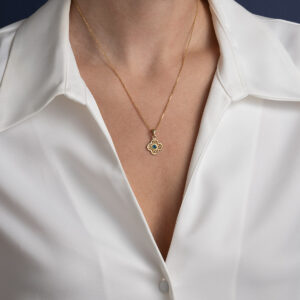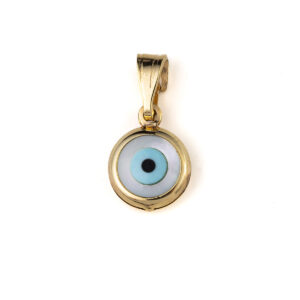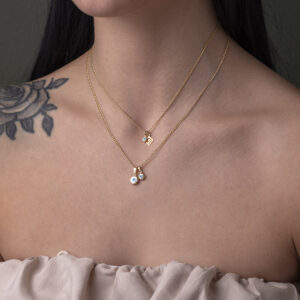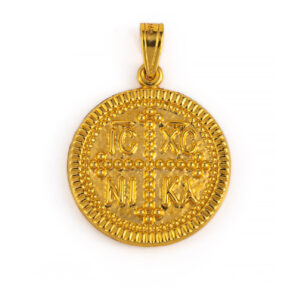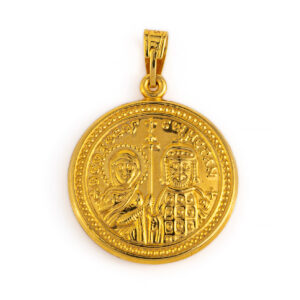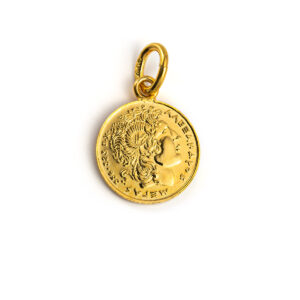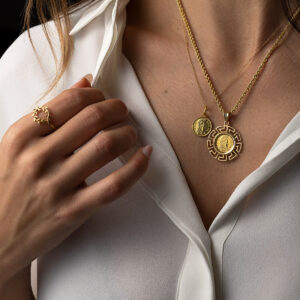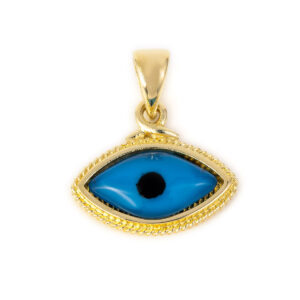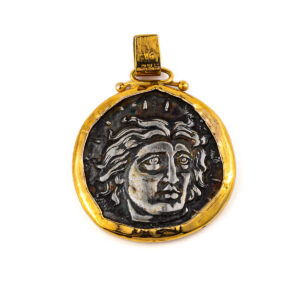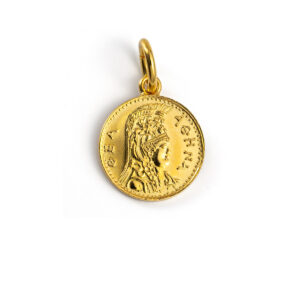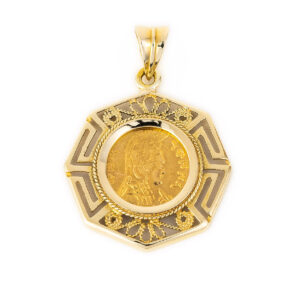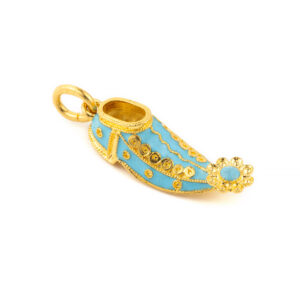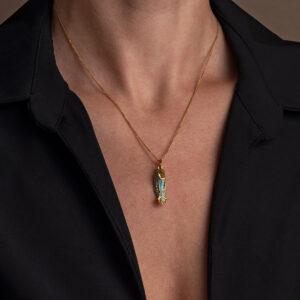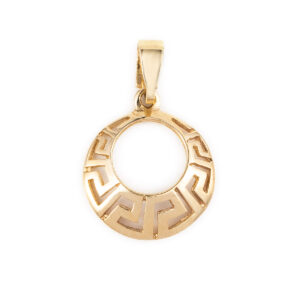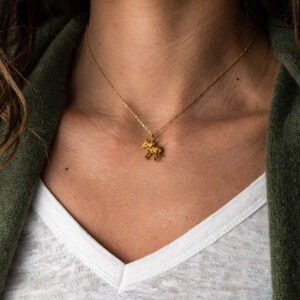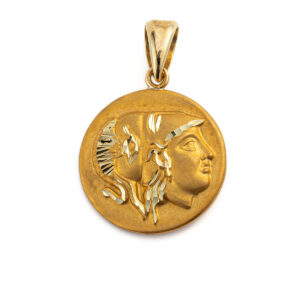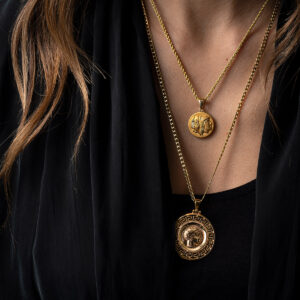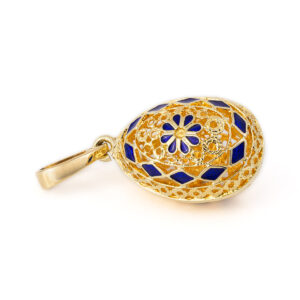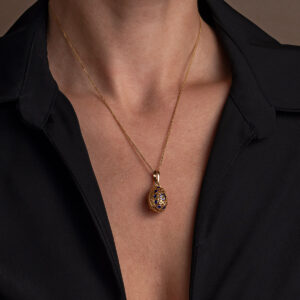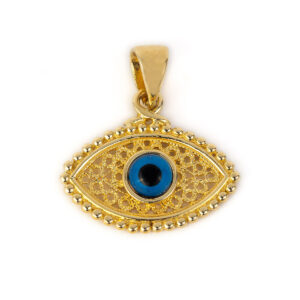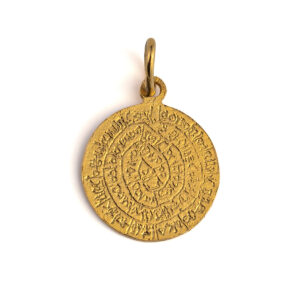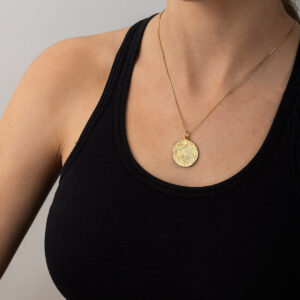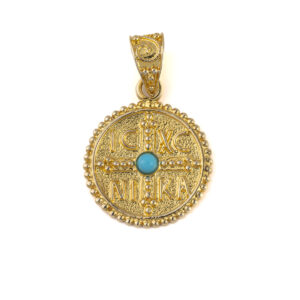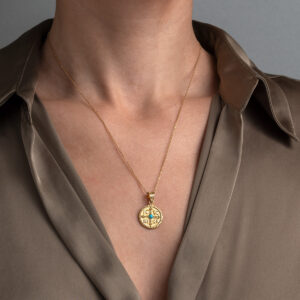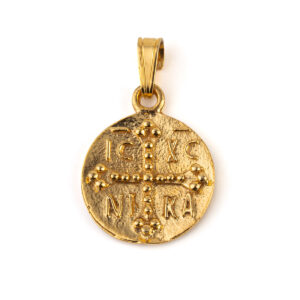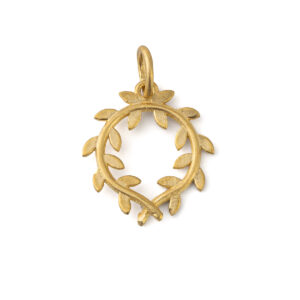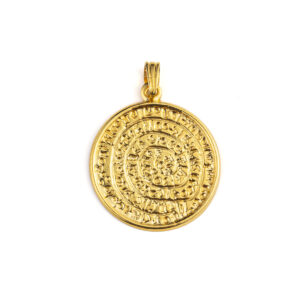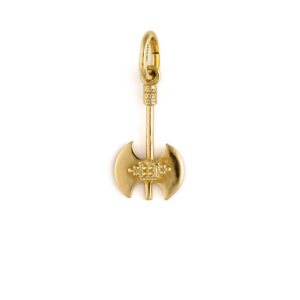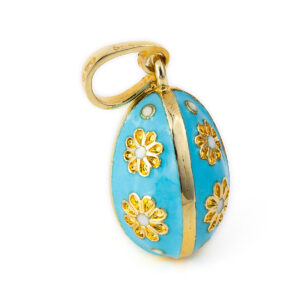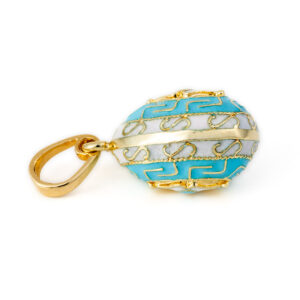Pendants
Filigree Cross Pendant with Evil Eye – 14K Gold
255,00€Cross Pendant embellished with a fine filigree and Evil Eye symbol.
Handmade with great attention to detail.
Inspired by the Byzantine Historical period respecting Greek art.
Made in 14k gold.
Evil Eye
The symbol and superstition of the evil eye is one of the strongest symbolic images in the world. The earliest known evidence for belief in the evil eye goes back to ancient Greece and Rome. It is supposed to wear off evil to anyone who wears it and various cultures believe in that, however in Greece it’s blue because at that time blue eyes were not so common and were thought to give the evil eye, so the blue is like a mirror to them.
Filigree is a delicate kind of jewellery metalwork, made with tiny beads or twisted threads, or both in combination, soldered together or to the surface of an object of the same metal and arranged in artistic motifs. The art of filigree dates back to ancient history. The first of the found jewelry in this technique has been found in Mesopotamia and dates to thousands of years BC. In the ancient world and particularly in Asia Minor, this art grew at the highest level.
Alexander the Great Coin Pendant – 14K Gold and Sterling Silver
160,00€ – 360,00€Pendant inspired by the ancient Greek tetradrachm coin of Alexander the Great.
Made in 925⁰ sterling silver and 14k gold.
Handmade item.
This Ancient Greek coin represent the Alexander the Great on one side, and the Lysimachou on the other. Inscription reads : Lysimachou in greek fonts. Alexander the Great the King of Macedonia is considered one of the most important forms of world history. Lysimachus was a Macedonian officer and diadochus of Alexander the Great, who became a basileus in 306 BC, ruling Thrace, Asia Minor and Macedon.
Athena Greek Goddess Coin Pendant – 14K Gold and Sterling Silver
160,00€ – 430,00€One of the most popular ancient Greek coins illustrates Athena’s head on one side and the wisdom owl on the other.
Made in-house in 925⁰ sterling silver and 14k solid gold bezel and hook.
14K Gold Box Chain in Length 50cm (not included).
Goddess Athena and Owl – Athenian silver tetradrachm
Dracma was the currency used in Greece during several periods in its history. The tetradrachm was an Ancient Greek silver coin equivalent to fourdrachmae in Athens it replaced the earlier “heraldic” type of didrachms and it was in wide circulation from ca. 510 to ca. 38 BC. This coin belongs to the so-called “new style Athenian coins” minted between 166 and 64 B.C. and is considered one of the most popular ancient Greek coins which illustrate the portrait of Goddess Athena on the one side and the wisdom owl on the other. Athena is an ancient Greek goddess associated with wisdom, handicraft, and warfare. Athena was regarded as the patron and protectress of various cities across Greece, particularly the city of Athens, from which she most likely received her name. She’s usually shown in art wearing a helmet and holding a spear. Her major symbols include owls, olive trees, and snakes. Her temples were located atop the fortified Acropolis in the central part of the city. The Parthenon on the Athenian Acropolis is dedicated to her, along with numerous other temples and monuments. Her main festival in Athens was the Panathenaia, which was celebrated in midsummer and was the most important festival on the Athenian calendar. In the classical Olympian pantheon, Athena was regarded as the favorite daughter of Zeus. The owl traditionally accompanies Athena. Because of such association, the owl has been used as a symbol of knowledge and wisdom. The inscriptions contain the city’s “national” appellation (“ΑΘΕ», i.e. “of the Athenians”).
Round Evil Eye Pendant – 14K Gold
45,00€ – 110,00€Made of 14k gold.
The chain shown is our Cable Chain – 925 Sterling Silver and Gold Plated (not included).
Handmade in Greece.
Explore Mati Collection
Evil Eye
The symbol and superstition of the evil eye is one of the strongest symbolic images in the world. The earliest known evidence for belief in the evil eye goes back to ancient Greece and Rome. It is supposed to wear off evil to anyone who wears it and various cultures believe in that, however in Greece it’s blue because at that time blue eyes were not so common and were thought to give the evil eye, so the blue is like a mirror to them. Nowadays it’s widely known and has become a trend.
Constantinato Pendant in 14K Solid Yellow Gold
285,00€ – 680,00€A handmade gold pendant that depicts Saints Constantine and Helena on the one side and Christogram with the initials IC XC NIKA (Jesus Christ conquers) on the other side.
Is a unique pendant which you can offer to your special ones as a protection gift or buy it for yourself.
Handmade with the great attention to detail.
Made in 14k gold.
Alexander the Great Coin Pendant – 14K Solid Gold
325,00€Α beautiful and timeless Coin Pendant inspired by the ancient Greek tetradrachm coin of Alexander the Great. The back side is decorated with the Vergina symbol.
Made of 14k gold.
The chain shown is our 14K Gold Chain (not included)
Explore Coins Collection
History
This Ancient Greek coin represents the Alexander the Great on one side, and the Lysimachou on the other. The inscription reads : Lysimachou in Greek fonts. Alexander the Great the King of Macedonia is considered one of the most important forms of world history. Lysimachus was a Macedonian officer and diadochus of Alexander the Great, who became a basileus in 306 BC, ruling Thrace, Asia Minor and Macedon.
The Vergina Sun also known as the “Star of Vergina” is a rayed solar symbol appearing in ancient Greek art. The Vergina Sun proper has sixteen triangular rays. The name “Vergina Sun” became widely used after the archaeological excavations in and around the small town of Vergina, in northern Greece, during the late 1970s. As in all handmade items, there may be small differences in weight and dimensions and this is what makes them unique and precious.
Evil Eye Pendant in 14K Gold
340,00€Handmade with great attention to detail.
Inspired by the Byzantine Historical period respecting Greek art.
Made in 14k gold.
Evil Eye
The symbol and superstition of the evil eye is one of the strongest symbolic images in the world. The earliest known evidence for belief in the evil eye goes back to ancient Greece and Rome. It is supposed to wear off evil to anyone who wears it and various cultures believe in that, however in Greece it’s blue because at that time blue eyes were not so common and were thought to give the evil eye, so the blue is like a mirror to them.
Helios Sun God – Ancient Greek Rhodes Coin 14K Gold and Silver
140,00€ – 280,00€Handmade pendant, inspired by an ancient Greek tetradrachm coin of Rhodes.
Made in 925⁰ sterling silver and 14k gold.
As in all handmade items, there may be small differences in weight and dimensions and this is what makes them unique and precious.
This Ancient Greek coin illustrates Helios Sun God on the one side and the flower rhodon (rose), a symbol of Rhodes on the other. Inscription reads : “RHODION” in Greek fonts.
Helios, in Greek mythology, is the god and personification of the Sun, often depicted in art with a radiant crown and driving a horse-drawn chariot through the sky.
Goddess Athena and Wise Owl Pendant – 14K Gold
325,00€This coin illustrates the portrait of Goddess Athena on the one side and the wisdom owl on the other.
Α beautiful and timeless coin pendant.
Made in 14k gold.
The chain shown is our 14K Gold Chain (not included).
Goddess Athena and Owl – Athenian silver tetradrachm.
Dracma was the currency used in Greece during several periods in its history. The tetradrachm was an Ancient Greek silver coin equivalent to fourdrachmae in Athens it replaced the earlier “heraldic” type of didrachms and it was in wide circulation from ca. 510 to ca. 38 BC. This coin belongs to the so-called “new style Athenian coins” minted between 166 and 64 B.C. and is considered one of the most popular ancient Greek coins which illustrate the portrait of Goddess Athena on the one side and the wisdom owl on the other. Athena is an ancient Greek goddess associated with wisdom, handicraft, and warfare. Athena was regarded as the patron and protectress of various cities across Greece, particularly the city of Athens, from which she most likely received her name. She’s usually shown in art wearing a helmet and holding a spear. Her major symbols include owls, olive trees, and snakes. Her temples were located atop the fortified Acropolis in the central part of the city. The Parthenon on the Athenian Acropolis is dedicated to her, along with numerous other temples and monuments. Her main festival in Athens was the Panathenaia, which was celebrated in midsummer and was the most important festival on the Athenian calendar. In the classical Olympian pantheon, Athena was regarded as the favorite daughter of Zeus. The owl traditionally accompanies Athena. Because of such association, the owl has been used as a symbol of knowledge and wisdom. The inscriptions contain the city’s “national” appellation (“ΑΘΕ», i.e. “of the Athenians”). As in all handmade items, there may be small differences in weight and dimensions and this is what makes them unique and precious.
Goddess Athena Coin Pendant in 14K Gold
765,00€Α beautiful and timeless Coin Pendant with Goddess Athena
Made in 14k gold.
The chain shown is our 14K Gold Spiga Chain (not included)
As in all handmade items there may be small differences in weight and dimensions and this is what makes them unique and precious.
14k Yellow Gold Pendant Traditional Greek Tsarouhi
492,00€Have you witnessed the changing of the guards in Syntagma square? This is the most traditional shoe of Greece (tsarouhi). The pendant is decorated with turquoise enamel and rosette motif. The rosette (rose) is a timeless jewel, symbol and amulet. The origin of the term is the Greek word for rose – rodon (ρόδον). Its use began in the Mycenaean era and continues as far as the 2nd millennia BC. The Mycenaean Rosette is a motif that was widespread throughout Mesopotamia, Egypt, Greece and other ancient civilizations. Rosette or Rodax was probably the most popular and favorite decorative element in Mycenaean era, classical antiquity and Byzantine times.
Made in 14k yellow gold.
Used as a charm or as a pendant.
Design inspired by the Greek tradition
A tsarouchi (τσαρούχι) is a type of shoe, which is typically known nowadays as part of the traditional uniform worn by the Evzones of the Greek Presidential Guard. Their origin goes back to the Byzantine times. Originally, various types of similar shoes were worn all over the Balkans, but tsarouchia are mainly associated with the Greeks. They were the most common footwear worn by both urban and rural Greeks, mainly men, but also many women. After the Greek independence in early 19th century, their use was limited to isolated rural areas and nomadic populations. Tsarouciia provide a clear link with the origin of the Evzone uniform in the traditional Greek costume, and with the fact that Evzones were largely enlisted from rural mountainous regions of Greece. Nowadays they are almost exclusively used by the presidential guard and in various traditional festivals and dances along with other traditional Greek garments.(source wikipedia)
14k Gold Circle Meander Pendant
185,00€Pendant inspired by the Greek meander symbol.
Made in 14k gold.
The chain shown is our 14K Gold Box Chain in Length 50cm (not included).
Explore Meandros Collection
Meandros design is a decorative border constructed from a continuous line, shaped into a repeated motif. Such a design is also called the Greek fret or Greek key design, although these are modern designations. On the one hand, the name “meander” recalls the twisting and turning path of the Meander River in Asia Minor, and on the other hand, as Karl Kerenyi pointed out, “the meander is the figure of a labyrinth in linear form” the meaning is that there is no beginning and no end in some cases so it becomes the symbol of long life and eternity.
14k Gold Donkey Charm
580,00€14k Gold Donkey Charm
By the second millennium BC, the donkey was brought to Europe, possibly at the same time as viticulture was introduced, as the donkey is associated with the Syrian god of wine, Dionysus.
Used as a charm on a bracelet or as a pendant on a chain.
Handmade item.
The chain shown is our 14K Gold Chain in Length 40cm (not included).
Meandros Pendant – 14Κ Gold
45,00€A pendant inspired by the Greek meander symbol, known as well as the Greek Key.
Handmade in Greece. Made of 14Κ Gold.
The chain shown is our 14K Gold Cable Chain (not included).
Explore Meandros Collection
Meandros design is a decorative border constructed from a continuous line, shaped into a repeated motif. Such a design is also called the Greek fret or Greek key design, although these are modern designations. On the one hand, the name “meander” recalls the twisting and turning path of the Meander River in Asia Minor, and on the other hand, as Karl Kerenyi pointed out, “the meander is the figure of a labyrinth in linear form” the meaning is that there is no beginning and no end in some cases so it becomes the symbol of long life and eternity.
Conqueror’s Cross Constantinato Oval Pendant with Eye – 14K Solid Gold
204,00€Made of 14k gold.
The chain shown is not included.
As in all handmade items there may be small differences in weight and dimensions and this is what makes them unique and precious.
Athena and Owl Pendant – 14K Solid Gold
646,00€This coin illustrates the portrait of Goddess Athena on the one side and the wisdom owl on the other.
Α beautiful and timeless coin pendant.
Made of 14k gold.
The chain shown is our 14K Gold Rope Chain (not included).
Goddess Athena and Owl – Athenian silver tetradrachm.
Dracma was the currency used in Greece during several periods in its history. The tetradrachm was an Ancient Greek silver coin equivalent to fourdrachmae in Athens it replaced the earlier “heraldic” type of didrachms and it was in wide circulation from ca. 510 to ca. 38 BC. This coin belongs to the so-called “new style Athenian coins” minted between 166 and 64 B.C. and is considered one of the most popular ancient Greek coins which illustrate the portrait of Goddess Athena on the one side and the wisdom owl on the other. Athena is an ancient Greek goddess associated with wisdom, handicraft, and warfare. Athena was regarded as the patron and protectress of various cities across Greece, particularly the city of Athens, from which she most likely received her name. She’s usually shown in art wearing a helmet and holding a spear. Her major symbols include owls, olive trees, and snakes. Her temples were located atop the fortified Acropolis in the central part of the city. The Parthenon on the Athenian Acropolis is dedicated to her, along with numerous other temples and monuments. Her main festival in Athens was the Panathenaia, which was celebrated in midsummer and was the most important festival on the Athenian calendar. In the classical Olympian pantheon, Athena was regarded as the favorite daughter of Zeus. The owl traditionally accompanies Athena. Because of such association, the owl has been used as a symbol of knowledge and wisdom. The inscriptions contain the city’s “national” appellation (“ΑΘΕ», i.e. “of the Athenians”).As in all handmade items there may be small differences in weight and dimensions and this is what makes them unique and precious.
14k Gold and Blue Enamel Filigree Egg Pendant
645,00€The pendant is embellished with fine filigree and blue enamel in Faberge style.
Used as a charm or as a pendant.
Pick up a beautiful gift inspired by the majestic art of Fabergé!
Made in 14k yellow gold.
Handmade in Greece.
History
Filigree is a delicate kind of jewelry metalwork, made with tiny beads or twisted threads, or both in combination, soldered together or to the surface of an object of the same metal and arranged in artistic motifs. The art of filigree dates back to ancient history. The first of the found jewelry in this technique has been found in Mesopotamia and dates to thousands of years BC. In the ancient world and particularly in Asia Minor, this art grew at the highest level.
Rosette The rosette (rose) is a timeless jewel, symbol, and amulet. The origin of the term is the Greek word for rose – rodon (ρόδον). Its use began in the Mycenaean era and continues as far as the 2nd millennia BC. The Mycenaean Rosette is a motif that was widespread throughout Mesopotamia, Egypt, Greece, and other ancient civilizations. Rosette or Rodax was probably the most popular and favorite decorative element in the Mycenaean era, classical antiquity, and Byzantine times.
Fabergé egg is a jeweled egg created by the House of Fabergé, in St. Petersburg, Imperial Russia. Virtually all were manufactured under the supervision of Peter Carl Fabergé between 1885 and 1917,[citation needed] the most famous being the 50 “Imperial” eggs, 43 of which survive, made for the Russian Tsars Alexander III and Nicholas II as Easter gifts for their wives and mothers. The first Fabergé egg was crafted for Tsar Alexander III, who had decided to give his wife, the Empress Maria Feodorovna, an Easter egg in 1885. Peter Carl Fabergé was a Russian jeweller best known for the famous Fabergé eggs made in the style of genuine Easter eggs, using precious metals and gemstones. He’s the founder of the famous jewelry legacy House of Fabergé.
Mycenaean Rosette Flower Pendant with Evil Eye symbol in 14K Gold
220,00€ – 390,00€Mycenaean Rosette Flower Pendant with Evil Eye symbol in 14K Gold
Handmade with great attention to detail. Inspired by the Ancient Greek history.
The chain shown is our 14K Gold Chain in Length 40cm (not included).
Evil Eye
The symbol and superstition of the evil eye is one of the strongest symbolic images in the world. The earliest known evidence for belief in the evil eye goes back to ancient Greece and Rome. It is supposed to wear off evil to anyone who wears it and various cultures believe in that, however in Greece it’s blue because at that time blue eyes were not so common and were thought to give the evil eye, so the blue is like a mirror to them. Nowadays it’s widely known and has become a trend.
Rosette flower
The rosette (rose) is a timeless jewel, symbol and amulet. The origin of the term is the Greek word for rose – rodon (ρόδον). Its use began in the Mycenaean era and continues as far as the 2nd millennia BC. The Mycenaean Rosette is a motif that was widespread throughout Mesopotamia, Egypt, Greece and other ancient civilizations. It is inspired by a Mycenaean rosette bead, found at Mycenae, dated to 1400-1300 B.C. The rosette were used extensively in ancient Greek Mycenaean jewels, in architecture, pottery and in sculptures from 1500 BC. Mycenaean rosettes usually had 6 or 8 or 12 leaves, and sixteen leaves during the Macedonian Dynasty. Such details as the rodax shape and the number of leaves tend to vary with the era or beliefs. The rosettes were used to decorate the cloths, belts and wreaths of the Kings. The number of leaves had a symbolic character each time. The four elements of nature (wind, earth, fire, water), the seven wonders of the ancient world or the twelve gods of ancient Greeks and the world domination and radiance of the Kings of Macedonia. They were signs of beauty, purity, eugenics, worship and power. Rosette or Rodax was probably the most popular and favorite decorative element in Mycenaean era, classical antiquity and Byzantine times.
14K Gold Filigree Byzantine Evil Eye Pendant
220,00€ – 374,00€Evil Eye Pendant embellished with a fine filigree.
Handmade with great attention to detail.
Inspired by the Byzantine Historical period respecting Greek art.
Made in 14k gold.
Evil Eye
The symbol and superstition of the evil eye is one of the strongest symbolic images in the world. The earliest known evidence for belief in the evil eye goes back to ancient Greece and Rome. It is supposed to wear off evil to anyone who wears it and various cultures believe in that, however in Greece it’s blue because at that time blue eyes were not so common and were thought to give the evil eye, so the blue is like a mirror to them.
Filigree is a delicate kind of jewellery metalwork, made with tiny beads or twisted threads, or both in combination, soldered together or to the surface of an object of the same metal and arranged in artistic motifs. The art of filigree dates back to ancient history. The first of the found jewelry in this technique has been found in Mesopotamia and dates to thousands of years BC. In the ancient world and particularly in Asia Minor, this art grew at the highest level.
14k Gold Phaistos Disc Pendant
272,00€ – 510,00€Phaistos Disc Pendant in 14k Gold. The Phaistos Disc is a disk of fired clay from the Minoan palace of Phaistos on the island of Crete. Now, the island of Crete is part of modern Greece. The disc was discovered in 1908 by the Italian archaeologist Luigi Pernier in the Minoan palace-site of Phaistos. While it is not clear that it is a script, most attempted decipherments assume that it is; most additionally assume a syllabary, others an alphabet or logography or a calendar.
Handmade item.
Phaistos Disc Pendant 14k Gold
204,00€ – 850,00€A pendant inspired by the ancient disk found in Phaistos.
Made of 14k gold.
Handmade in Greece.
The chain shown is our 14K Gold Chain (not included).
Explore Phaistos Disc Collection
History
The Phaistos Disc is a disk of fired clay from the Minoan palace of Phaistos on the island of Crete. Now, the island of Crete is part of modern Greece. The disc was discovered in 1908 by the Italian archaeologist Luigi Pernier in the Minoan palace-site of Phaistos. While it is not clear that it is a script, most attempted decipherments assume that it is; most additionally assume a syllabary, others an alphabet or logography or a calendar.
Constantinato Pendant with Turquoise – Gold 14K
578,00€A handmade gold Constantinato pendant that depicts a cross on the one side and Saints Constantine and Helena on the other side.
A unique pendant that you can offer to your special ones as a protection gift or buy it for yourself.
Made of 14k gold.
Handmade in Greece.
The chain shown is our Cable Chain in 14K Gold (not included).
Constantine Coin Pendant – 14K Gold
190,00€ – 275,00€A handmade gold pendant that depicts Saints Constantine and Helena on the one side and Christogram with the initials IC XC NIKA (Jesus Christ conquers) on the other side.
Is a unique necklace which you can offer to your special ones as a protection gift or buy it for yourself.
Handmade with the great attention to detail.
Made of 14k gold.
Explore Byzantine Collection
Olive Wreath Pendant – 14K Gold
145,00€A pendant inspired by the olive branch, a symbol of peace, abundance and achievement.
Made of 14K gold.
Handmade item.
The chain shown is our Cable Chain in 14K Gold (not included).
The olive wreath also known as kotinos was the prize for the winner at the ancient Olympic Games. It was an olive branch, of the wild- olive tree that grew at Olympia, intertwined to form a circle or a horse-shoe. According to Pausanias it was introduced by Heracles as a prize for the running race winner to honor his father Zeus. In the ancient Olympic Games there were no gold, silver, or bronze medals. There was only one winner per event, crowned with an olive wreath made of wild-olive leaves from a sacred tree near the temple of Zeus at Olympia. Olive wreaths were given out during the 2004 Summer Olympics in Athens in honor of the ancient tradition, because the games were being held in Greece.
Phaistos Disc Pendant 14K Gold
160,00€ – 265,00€The Phaistos Disc is a disk of fired clay from the Minoan palace of Phaistos on the island of Crete. Now, the island of Crete is part of modern Greece. The disc was discovered in 1908 by the Italian archaeologist Luigi Pernier in the Minoan palace-site of Phaistos. While it is not clear that it is a script, most attempted decipherments assume that it is; most additionally assume a syllabary, others an alphabet or logography or a calendar.
Handmade item.
Minoan Double Axe Pendant – 14K Yellow Gold
170,00€ – 272,00€Pendant inspired by the Minoan double axe, known as labrys.
Made of 14K Gold.
Handmade item.
The chain shown is our 14K Gold Chain in Length 40cm (not included).
Explore Heritage Collection
Labrys is, according to Plutarch, Minoan word for the double-headed axe called in Greek πέλεκυς (pélekus). In ancient Crete, the double axe was an important sacred symbol of the Minoan religion. In Crete it never accompanies male gods, but always female goddesses. It seems that it is associated with the worship of Mother Earth or Great Goddess.
As in all handmade items, there may be small differences in weight and dimensions and this is what makes them unique and precious.
Goddess Athena Coin Pendant – 14K Gold
646,00€Α beautiful and timeless Coin Pendant with Goddess Athena.
– Athena is the daughter of Zeus and the goddess of wisdom, handicraft, and warfare. Athena was a protector of the city of Athens, from which she most likely received her name.
Made in 14k gold.
The chain shown is our 14K Gold Chain in Length 40cm (not included).
Dracma was the currency used in Greece during several periods in its history: The tetradrachm was an Ancient Greek silver coin equivalent to fourdrachmae in Athens it replaced the earlier “heraldic” type of didrachms and it was in wide circulation from ca. 510 to ca. 38 BC. This coin is one of the most popular ancient Greek coins which illustrates the portrait of the Goddess Athena. Athena is the daughter of Zeus and the goddess of wisdom, handicraft, and warfare. Athena was a protector of the city of Athens, from which she most likely received her name. Her temples were located atop the fortified Acropolis in the central part of the city. The Parthenon on the Athenian Acropolis is dedicated to her, along with numerous other temples and monuments. Her main festival in Athens was the Panathenaia, which was celebrated in midsummer and was the most important festival on the Athenian calendar.
As in all handmade items there may be small differences in weight and dimensions and this is what makes them unique and precious.
14k Gold Filigree Wisdom Owl Pendant
210,00€Wisdom Owl Pendant embellished with a fine filigree.
Made in 14k gold.
Filigree Egg Pendant with Flowers – 14k Gold and Turquoise Enamel
612,00€ – 952,00€The pendant is embellished with flowers in Faberge style.
Used as a charm or as a pendant.
Pick up a beautiful gift inspired by the majestic art of Fabergé!
Made in 14k gold and turquoise enamel.
The chain shown is our 14K Gold Chain (not included).
The rosette (rose) is a timeless jewel, symbol, and amulet. The origin of the term is the Greek word for rose – rodon (ρόδον). Its use began in the Mycenaean era and continues as far as the 2nd millennia BC. The Mycenaean Rosette is a motif that was widespread throughout Mesopotamia, Egypt, Greece, and other ancient civilizations. Rosette or Rodax was probably the most popular and favorite decorative element in the Mycenaean era, classical antiquity, and Byzantine times.
Fabergé egg is a jeweled egg created by the House of Fabergé, in St. Petersburg, Imperial Russia. Virtually all were manufactured under the supervision of Peter Carl Fabergé between 1885 and 1917,[citation needed] the most famous being the 50 “Imperial” eggs, 43 of which survive, made for the Russian Tsars Alexander III and Nicholas II as Easter gifts for their wives and mothers. The first Fabergé egg was crafted for Tsar Alexander III, who had decided to give his wife, Empress Maria Feodorovna, an Easter egg in 1885. Peter Carl Fabergé was a Russian jeweler best known for the famous Fabergé eggs made in the style of genuine Easter eggs, using precious metals and gemstones. He’s the founder of the famous jewelry legacy House of Fabergé.
As in all handmade items, there may be small differences in weight and dimensions, making them unique and precious.
Egg Pendant with Rosette Flowers – 14k Gold
680,00€The pendant is embellished with rosette flowers in Faberge style.
Used as a charm or as a pendant.
Pick up a beautiful gift inspired by the majestic art of Fabergé!
Made in 14k gold and turquoise enamel.
Fabergé egg is a jeweled egg created by the House of Fabergé, in St. Petersburg, Imperial Russia. Virtually all were manufactured under the supervision of Peter Carl Fabergé between 1885 and 1917,[citation needed] the most famous being the 50 “Imperial” eggs, 43 of which survive, made for the Russian Tsars Alexander III and Nicholas II as Easter gifts for their wives and mothers. The first Fabergé egg was crafted for Tsar Alexander III, who had decided to give his wife, Empress Maria Feodorovna, an Easter egg in 1885. Peter Carl Fabergé was a Russian jeweler best known for the famous Fabergé eggs made in the style of genuine Easter eggs, using precious metals and gemstones. He’s the founder of the famous jewelry legacy House of Fabergé.
The rosette (rose) is a timeless jewel, symbol, and amulet. The origin of the term is the Greek word for rose – rodon (ρόδον). Its use began in the Mycenaean era and continues as far as the 2nd millennia BC. The Mycenaean Rosette is a motif that was widespread throughout Mesopotamia, Egypt, Greece, and other ancient civilizations. Rosette or Rodax was probably the most popular and favorite decorative element in the Mycenaean era, classical antiquity, and Byzantine times.
As in all handmade items, there may be small differences in weight and dimensions, making them unique and precious.
Meander Egg Pendant with Spear Motif – 14k Gold and Enamel
645,00€The pendant is embellished with a Meander design and spear motif in Faberge style.
Used as a charm or as a pendant.
Pick up a beautiful gift inspired by the majestic art of Fabergé!
Made in 14k yellow gold and turquoise and white enamel
Fabergé egg is a jeweled egg created by the House of Fabergé, in St. Petersburg, Imperial Russia. Virtually all were manufactured under the supervision of Peter Carl Fabergé between 1885 and 1917,[citation needed] the most famous being the 50 “Imperial” eggs, 43 of which survive, made for the Russian Tsars Alexander III and Nicholas II as Easter gifts for their wives and mothers. The first Fabergé egg was crafted for Tsar Alexander III, who had decided to give his wife, Empress Maria Feodorovna, an Easter egg in 1885. Peter Carl Fabergé was a Russian jeweler best known for the famous Fabergé eggs made in the style of genuine Easter eggs, using precious metals and gemstones. He’s the founder of the famous jewelry legacy House of Fabergé.
Meander or Meandros design, one of the most historic symbols of the Greek World, also called Greek Key and symbolizes long life and eternity.
As in all handmade items, there may be small differences in weight and dimensions, making them unique and precious.
Enamel Goddess Athena Coin Pendant – 14K Gold
578,00€Α beautiful and elegant Coin Pendant with Goddess Athena
The front side of this pendant is decorated with Goddess Athena and the back side is decorated with the wisdom owl
Made in 14k gold and blue enamel.
Handmade in Greece.
The chain shown is our 14K Gold Chain (not included).
Explore Coins Collection
Goddess Athena and Owl – Athenian silver tetradrachm
Dracma was the currency used in Greece during several periods in its history.
The tetradrachm was an Ancient Greek silver coin equivalent to fourdrachmae in Athens it replaced the earlier “heraldic” type of didrachms and it was in wide circulation from ca. 510 to ca. 38 BC.
This coin belongs to the so-called “new style Athenian coins” minted between 166 and 64 B.C. and is considered one of the most popular ancient Greek coins which illustrate the portrait of Goddess Athena on the one side and the wisdom owl on the other. Athena is an ancient Greek goddess associated with wisdom, handicraft, and warfare.
Athena was regarded as the patron and protectress of various cities across Greece, particularly the city of Athens, from which she most likely received her name. She’s usually shown in art wearing a helmet and holding a spear. Her major symbols include owls, olive trees, and snakes. Her temples were located atop the fortified Acropolis in the central part of the city. The Parthenon on the Athenian Acropolis is dedicated to her, along with numerous other temples and monuments. Her main festival in Athens was the Panathenaia, which was celebrated in midsummer and was the most important festival on the Athenian calendar.
In the classical Olympian pantheon, Athena was regarded as the favorite daughter of Zeus. The owl traditionally accompanies Athena. Because of such association, the owl has been used as a symbol of knowledge and wisdom. The inscriptions contain the city’s “national” appellation (“ΑΘΕ», i.e. “of the Athenians”).
As in all handmade items there may be small differences in weight and dimensions and this is what makes them unique and precious.


